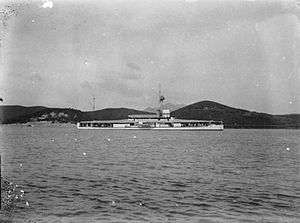HMS Gnat (T60)
HMS Gnat was a Royal Navy Insect class gunboat. She was built by Lobnitz and launched in 1915.
 HMS Gnat (T60) at China Station 1922 | |
| History | |
|---|---|
| Name: | HMS Gnat (T60) |
| Builder: | Lobnitz |
| Fate: | Constructive Loss |
| Status: | Scrapped 1945 |
| General characteristics | |
| Class and type: | Insect-class gunboat |
| Displacement: | 625 long tons (635 t) |
| Length: | 237 ft 6 in (72.39 m) |
| Beam: | 36 ft (11 m) |
| Draught: | 4 ft (1.2 m) |
| Propulsion: | 2 shaft VTE engines, 2 Yarrow type mixed firing boilers 2000 IHP |
| Speed: | 14 knots (16 mph; 26 km/h) |
| Complement: | 55 |
| Armament: |
|
| Armour: | Improvised |
History
During the First World War, Gnat took part in the Mesopotamian Campaign as part of the gunboat squadron operating on the Euphrates and Tigris rivers. In 1927 the Gnat participated as part of a Royal Navy flotilla in the Nanking Incident, helping to protect British and other international citizens and business interests in China.
From 1936, Gnat had a "ship's dog", a pure-bred liver and white Pointer called Judy.[1]
During the Second World War, Gnat was part of the China Station until 1940, when she was relieved by HMS Grasshopper. She then transferred to the Mediterranean Fleet's Inshore Squadron. Along with Stuart, Vampire, Voyager and Terror, she supported the 6th Australian Division's assault on Tobruk on 21 January 1941 with the port being secured on 22nd.[2] She was torpedoed on 21 October 1941 by the U-79 but she was towed and beached at Alexandria and used as a fixed Anti-aircraft platform.
Declared a constructive total loss, she was finally scrapped in 1945.
References
- Lewis, Damien (2014). Judy: A Dog in a Million. London: Quercus. ISBN 978-1-848-66542-2.
- Lind & Payne 1976 p. 65
Bibliography
- Lenton, H. T.; Colledge, J. J. (1973). Warships of World War II. Ian Allan Ltd. ISBN 978-0711004030.
- Lind, L. J.; Payne, A. (1976). Scrap Iron Destroyers; The story of HMA Ships Stuart, Vampire, Vendetta, Voyager and Waterhen. Garden Island: The Naval Historical Society of Australia. ISBN 0909153043.